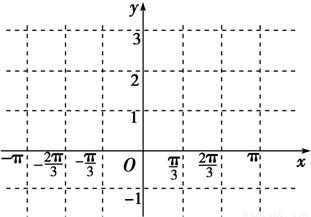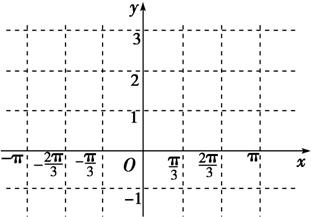题目内容
已知a=2(cosωx,cosωx),b=(cosωx, sinωx)(其中0<ω<1),函数f(x)=a•b,若直线x=
sinωx)(其中0<ω<1),函数f(x)=a•b,若直线x= 是函数f(x)图象的一条对称轴,
是函数f(x)图象的一条对称轴,(1)试求ω的值;
(2)先列表再作出函数f(x)在区间[-π,π]上的图象.

【答案】分析:(1)利用两个向量的数量积化简f(x)的解析式,由题意知,x= 时,函数f(x)取最值,故有
时,函数f(x)取最值,故有  +
+ =kπ+
=kπ+ (k∈Z).
(k∈Z).
依据k、ω的范围求出它们的值.
(2)根据五点法作图的方法,分别令自变量x取-π、- 、-
、- 、
、 、
、 、π,分别求出函数f(x)的值,
、π,分别求出函数f(x)的值,
依据正弦函数的图象特点,在坐标系中描点作图.
解答:解:f(x)= •
• =2(cosωx,cosωx)•(cosωx,
=2(cosωx,cosωx)•(cosωx, sinωx)
sinωx)
=2cos2ωx+2 cosωxsinωx
cosωxsinωx
=1+cos2ωx+ sin2ωx=1+2sin(2ωx+
sin2ωx=1+2sin(2ωx+ ).
).
(1)∵直线x= 为对称轴,∴sin(
为对称轴,∴sin( +
+ )=±1,
)=±1,
∴ +
+ =kπ+
=kπ+ (k∈Z).
(k∈Z).
∴ω= k+
k+ ,∵0<ω<1,
,∵0<ω<1,
∴- <k<
<k< ,∴k=0,ω=
,∴k=0,ω= .
.
(2)由(1)知,f(x)=1+2sin(x+ ).
).
列表:

描点作图,函数f(x)在[-π,π]上的图象如图所示.

点评:本题考查两个向量的数量积公式的应用,两角和差的三角函数公式的应用,以及用五点法作y=Asin(ωx+φ)的图象.
 时,函数f(x)取最值,故有
时,函数f(x)取最值,故有  +
+ =kπ+
=kπ+ (k∈Z).
(k∈Z).依据k、ω的范围求出它们的值.
(2)根据五点法作图的方法,分别令自变量x取-π、-
 、-
、- 、
、 、
、 、π,分别求出函数f(x)的值,
、π,分别求出函数f(x)的值,依据正弦函数的图象特点,在坐标系中描点作图.
解答:解:f(x)=
 •
• =2(cosωx,cosωx)•(cosωx,
=2(cosωx,cosωx)•(cosωx, sinωx)
sinωx)=2cos2ωx+2
 cosωxsinωx
cosωxsinωx=1+cos2ωx+
 sin2ωx=1+2sin(2ωx+
sin2ωx=1+2sin(2ωx+ ).
).(1)∵直线x=
 为对称轴,∴sin(
为对称轴,∴sin( +
+ )=±1,
)=±1,∴
 +
+ =kπ+
=kπ+ (k∈Z).
(k∈Z).∴ω=
 k+
k+ ,∵0<ω<1,
,∵0<ω<1,∴-
 <k<
<k< ,∴k=0,ω=
,∴k=0,ω= .
.(2)由(1)知,f(x)=1+2sin(x+
 ).
).列表:

描点作图,函数f(x)在[-π,π]上的图象如图所示.

点评:本题考查两个向量的数量积公式的应用,两角和差的三角函数公式的应用,以及用五点法作y=Asin(ωx+φ)的图象.

练习册系列答案
 阅读快车系列答案
阅读快车系列答案
相关题目
 已知a=2(cosωx,cosωx),b=(cosωx,
已知a=2(cosωx,cosωx),b=(cosωx, sinωx)(其中0<ω<1),函数f(x)=a•b,若直线x=
sinωx)(其中0<ω<1),函数f(x)=a•b,若直线x= 是函数f(x)图象的一条对称轴,
是函数f(x)图象的一条对称轴,
 sinωx)(其中0<ω<1),函数f(x)=a•b,若直线x=
sinωx)(其中0<ω<1),函数f(x)=a•b,若直线x= 是函数f(x)图象的一条对称轴,
是函数f(x)图象的一条对称轴,